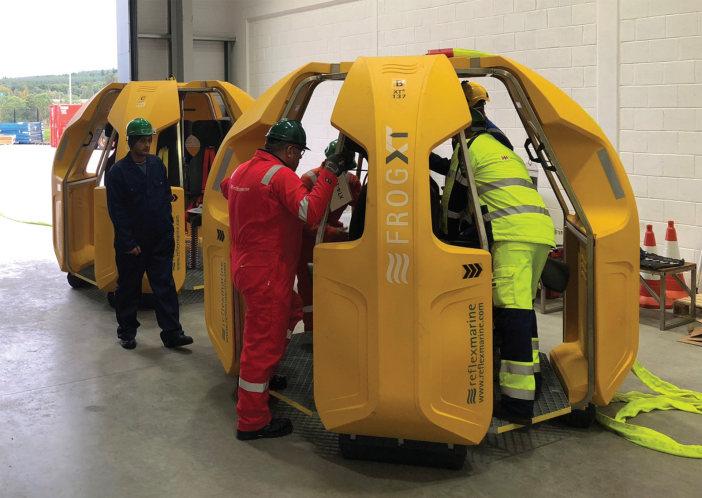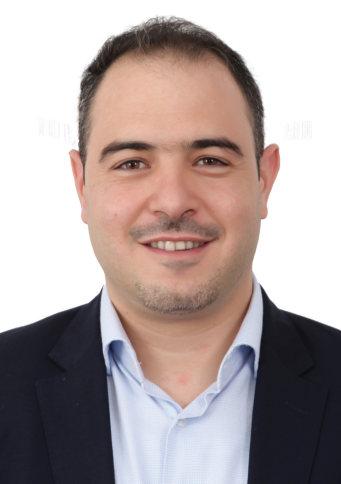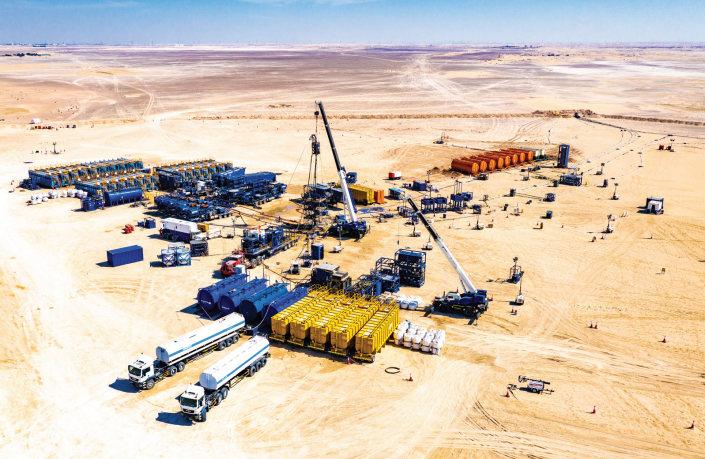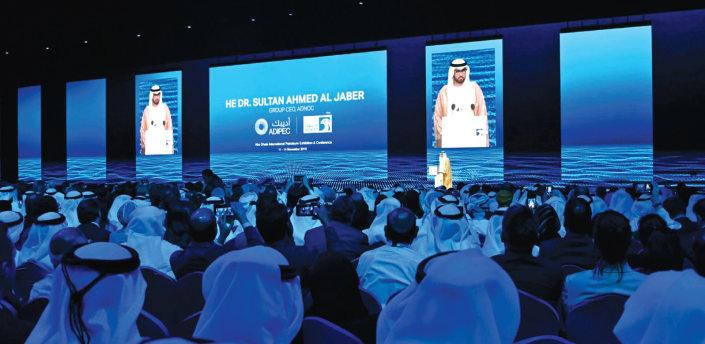
23 minute read
Developments
HALLIBURTON HAS INTRODUCED SmartFleet, the first intelligent automated fracturing system. SmartFleet, unlike any current fracturing fleet, gives operators real-time fracture control while pumping by integrating subsurface fracture measurements, live 3D visualisation and real-time fracture commands.
The SmartFleet system connects to the reservoir through subsurface sensing to continuously measure cluster uniformity and fracture geometry. The system applies the measurements to make intelligent adjustments that improve fracture placement. Additionally, SmartFleet provides users a direct line of sight to live, 3D fracture geometry, projected fracture growth, and crosswell interactions. With SmartFleet, operators can control fracture outcomes in ways not previously possible, through real-time The SmartFleet system connects to the reservoir through subsurface sensing. fracture decision making and commands. This includes automated actions while pumping to improve near-wellbore and far-field fracture placement, as well as directly manage frac hits.
“The SmartFleet system is the first of its kind, giving operators the ability to see and control how they land their fracs,” said Michael Segura, vice-president of production enhancement. “SmartFleet represents a step-change towards intelligent fracturing that gives operators the ability to optimise fracture outcomes while pumping, allowing them to drive capital efficiency and asset performance.”
Image credit: Adobe Stock
KCA Deutag secures contracts in Oman
GLOBAL DRILLING, ENGINEERING and technology provider, KCA Deutag (KCAD) has been awarded contracts worth more than US$150mn in Oman, from the country’s leading exploration and production companies.
The first award covers the provision of expert manpower for customer-owned rigs, hoists and workshops. In total, KCAD will provide approximately 420 people in delivering this contract. This is a five-year extension to a contract originally awarded in 2015. One-year contract extensions have also been awarded for eight KCAD rigs working in Oman.
Alongside these contract awards, KCAD’s T-82 rig has spudded the Group’s first well in Kuwait, representing a successful entry for the company into this attractive market. The rig is equipped with key components from Bentec, KCA Deutag’s leading global manufacturer of drilling rigs, oilfield and energy equipment.
Commenting on the awards, Simon Drew, president of Land, said, “These awards demonstrate that despite challenging markets, KCA Deutag’s operational strengths and capability at and beyond the rig site, continue to be recognised by our customers.”
Cyberhawk wins drone inspection contract
CYBERHAWK, A GLOBAL leader in drone-based inspection, has secured a five-year contract with a major LNG producer for the provision of drone inspection, surveying and data visualisation services. The contract will see Cyberhawk collect engineeringgrade inspection data from oil and gas assets in the Image credit: Cyberhawk Middle East, onshore and offshore, which will be delivered as detailed inspection reports via Cyberhawk’s drone data visualisation software, iHawk, which allows asset teams to view up-to-date, visual data securely in the cloud. The contract with the state-owned oil and gas company was secured by Manweir LLC, Cyberhawk’s Cyberhawk will provide drone inspection services for a major LNG producer. local partner, which is working closely with the technology firm to build a strong regional presence and establish in-country value for local operators. The agreement allows any local energy operator to enlist Cyberhawk’s technology solutions through this contract.
Chris Fleming, CEO at Cyberhawk, said, “This agreement is testament to the high standard of work that Cyberhawk has been delivering in the Middle East region for the past 10 years. By working closely with the client and local authorities, we were able to obtain the Minister of Interior permit to fly in-country.
“This is an extremely exciting partnership, where knowledge will be shared to benefit the local economy and businesses and allow oil and gas producers to thrive in the new digital era.”
ADNOC to maximise smart growth through partnerships
DR SULTAN AHMED Al Jaber, UAE Minister of industry and advanced technology and Group CEO of the Abu Dhabi National Oil Company (ADNOC), shared insights on energy market dynamics, the energy transition and ADNOC’s future strategy during a virtual session of the Energy Intelligence Forum.
Speaking with Alex Schindelar, president of Energy Intelligence, during a leadership dialogue, Dr Al Jaber said, “When it comes to managing the economic impact of Covid, it really comes down to the fact that we are realising the benefits of the transformation we started four years ago. Over this period we have focused on improving our performance and strengthening our agility while always reinforcing efficiency throughout our business. Most importantly we have focused on what we can control, and that is our costs.
“Going forward, we will continue to focus on developing our upstream resources and expanding our downstream footprint here in the UAE, while maximising value through creative partnerships. In addition, we are further strengthening our marketing and trading capabilities. Last month we completed our first derivatives trade, marking the beginning of a new era for ADNOC as an active trader.”
Commenting on how ADNOC and Abu Dhabi have continued to attract investment in 2020 following ADNOC’s multi-billion dollar deals, Dr Al Jaber added that the deals were as a result of the fact that the UAE has created a safe, reliable, and stable business environment, underpinned by a unique partnership model. He noted this business environment is very attractive to the global investment community who view the UAE as a highly trusted, go-to investment destination.
Responding to a question on ADNOC’s strategy behind monetising assets, Dr Al Jaber noted that ADNOC’s strategy is very much focused on unlocking value and driving growth through smart, creative partnerships. He stressed ADNOC “will continue to leave no stone unturned to maximise value from across our portfolio.”
Additionally, he emphasised that while no one is in a position to predict what the shape of economic recovery will look like over the next few months given that there are multiple variables at play, the long-term structural market for oil and gas is very robust, with demand expected to increase to 109mn bpd over the next 25 years, in line with global economic growth.

DNV GL and Aker BP remotely inspect offshore cranes
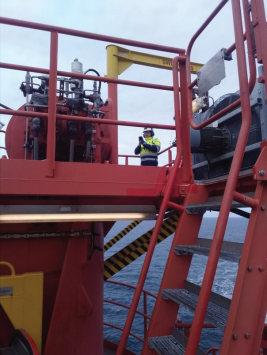
IN A PILOT project, DNV GL and Aker BP have remotely performed inspections on three of their offshore cranes on the Norwegian continental shelf.
DNV GL has performed remote safety inspections of one box boom pedestal crane on the Valhall Flank West and two knuckle boom cranes on the Skarv field, both as part of annual surveys.
On the installations, crane operators and specialised crane technicians on board the platforms used tablets to take close-up video and pictures based on an agreed checklist of selected safety functions, which were shared with DNV GL’s onshore inspectors. On the Valhall Flank West platform, which is normally unmanned, the one-year old crane, manufactured by NOV, featured auto-testing of the automatic overload protection system (AOPS). Aker BP - Skarv crane.
A similar inspection programme is being performed on two knuckle boom cranes on the FPSO located in the Skarv field. As Aker BP’s northernmost producing field, it boasts one of the worlds’ largest offshore gas processing plants.
Image credit: DNV GL
Planned gas investments in MENA rise by 29%
DESPITE THE GLOBAL demand shock, MENA committed gas investments are holding steady while planned gas investments reach US$126bn, a 29% increase compared to last year, according to APICORPS’s MENA Gas & Petrochemicals Investments Outlook 2020-2024.
The report features major developments in the regional gas and petrochemicals landscape and the dynamics shaping it over the short and medium terms.
The year 2020 is witnessing one of the biggest gas demand shocks on record, with a yearon-year reduction of 4% globally. This stands in stark contrast to 2019, which was a record year for LNG Final Investment Decisions (FIDs). The 2020 global crisis is expected to reduce the annual growth rate for global gas demand during 2020-24 to 1.5% compared to the preCOVID-19 estimate of 1.8%.
The increase in planned investments is mainly due to the strong ongoing regional gas drive for cleaner power generation and improved monetisation as a feedstock for the industrial and petrochemicals sectors. Notably, the petrochemicals sector witnessed a year-on-year increase of US$4bn in planned projects compared to last year’s outlook, while committed projects decreased by US$13bn due to the completion of several projects in 2019.
Penspen wins EPC contract from Target Engineering Construction Company
PENSPEN HAS BEEN awarded a detailed engineering contract for crude receiving facilities at Jebel Dhana from Target Engineering Construction Company, an engineering, procurement and construction (EPC) contractor in Abu Dhabi, UAE.
Under the terms of the contract, Penspen will be responsible for the development of facilities for unloading the Upper Zakum (UZ) field and Non-System (NS) crudes at Jebel Dhana from tankers. The work will be carried out using the Penspen will develop facilities for unloading the Upper Zakum (UZ) field and Non-System (NS) crudes at Jebel Dhana from tankers. existing single point mooring (SPM-2), subsea pipeline, onshore pipeline and gravity pipeline to the three large tanks already in place. Both UZ and NS crudes will be blended and the crude will be transferred to Ruwais Refinery West to feed the crude oil distillation unit (CDU) with 420,000 bpd.
Target Engineering Construction Company offers in-house services for major construction disciplines in onshore and offshore areas, with more than 40 years’ experience in the oil and gas sector. This contract is the second that the company has awarded to Penspen this year.
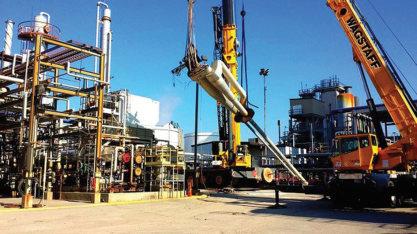
Image credit: John R Perry/Pixabay
Reshaping the future of energy
THE ERA OF global oil demand growth will come to an end in the next decade, but a rapid decline is unlikely without a large shift in government policies, according to the newly-launched World Energy Outlook 2020, the International Energy Agency’s flagship publication.
The COVID-19 crisis has caused more disruption to the global energy system than any other event in recent history. But whether this upheaval ultimately helps or hinders efforts to accelerate clean energy transitions will depend on how governments respond to today’s challenges, the IEA argues. A surge in welldesigned energy policies is needed to put the world on track for a resilient energy system that can meet climate goals.
Image credit: Jonathan Cutrer/Flickr Renewables feature strongly in all the IEA’s scenarios.
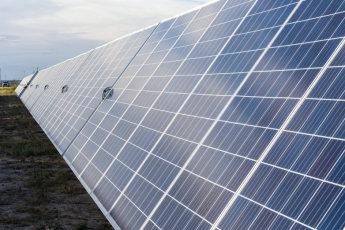
The new report provides the latest IEA analysis of the pandemic’s impact: global energy demand is set to drop by 5% in 2020, energy-related CO2 emissions by 7%, and energy investment by 18%. The WEO compares different scenarios that show how the energy sector could develop over the next 10 years.
In the Stated Policies Scenario, which reflects today’s announced policy intentions and targets, global energy demand rebounds to its pre-crisis level in early 2023. However, this does not happen until 2025 in the event of a prolonged pandemic and deeper slump. Slower demand growth lowers the outlook for oil and gas prices compared with pre-crisis trends. But large falls in investment increase the risk of future market volatility.
Renewables feature strongly in all the IEA’s scenarios, with solar centre stage. Supportive policies and maturing technologies are enabling very cheap access to capital in leading markets. Solar PV is now consistently cheaper than new coal- or gas-fired power plants in most countries, and solar projects now offer some of the lowest cost electricity ever seen. In the Stated Policies Scenario, renewables meet 80% of global electricity demand growth over the next decade.
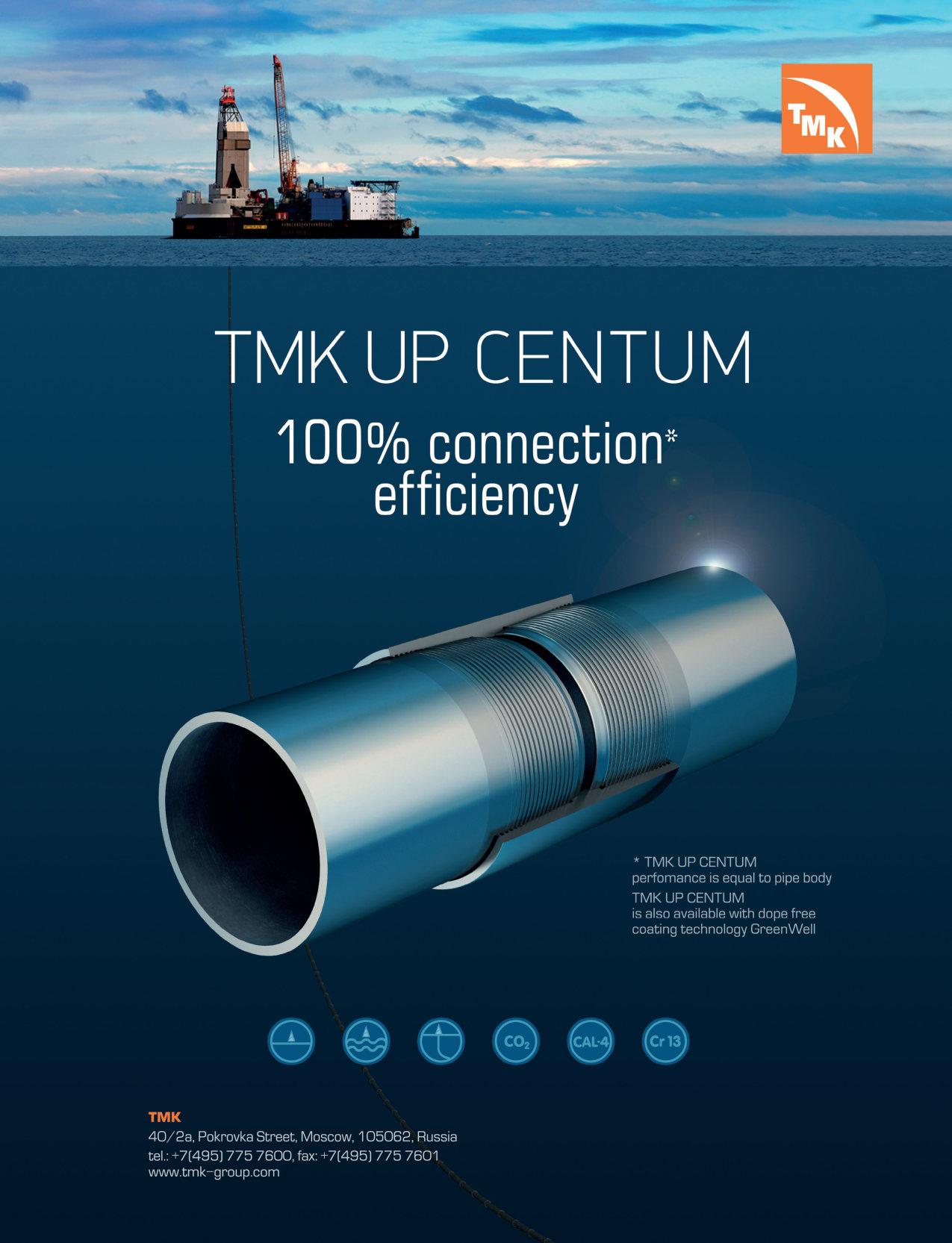
Alfa Laval secures natural gas order in Algeria
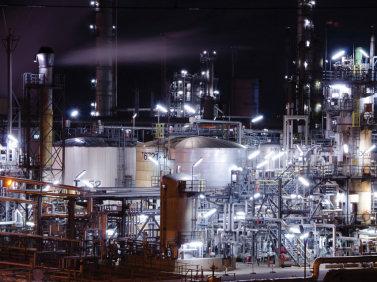
ALFA LAVAL, A specialist in heat transfer, centrifugal separation and fluid handling, has won an order to supply Alfa Laval The delivery of the heat exchangers is scheduled for 2021. OLMI heat exchangers to a gas compression plant in Algeria.
The order has a value of approximately US$8.4mn and was booked late September in the Welded Heat Exchangers unit of the Energy Division. The company noted that the delivery is scheduled for 2021. The order comprises of Alfa Laval OLMI heat exchangers which will be used for natural gas cooling applications in different gas compression stations.
“I am very pleased to announce this order for our OLMI heat exchangers, booked late in September,” said Susanne Pahlén Åklundh, president of the energy division. “These heat exchangers which handle high pressure and temperatures are both reliable and efficient.”
Alfa Laval is active in the energy, marine, and food and water sectors. Its main technology areas include heat transfer, separation and fluid handling.
Image credit: : Kaleb W/Flickr
Honeywell, Wolters Kluwer team up to help employees safely return to the workplace
HONEYWELL AND WOLTERS Kluwer have announced a collaboration to integrate Honeywell’s Industrial Internet of Things (IIoT) connected devices and safety software with the risk and environmental, health and safety (EHS) software from Enablon, a Wolters Kluwer business.
The collaboration is designed to enable enterprises in asset-intensive industries to improve their risk, safety and operational excellence programmes.
The collaboration enables customers to monitor their EHS performance, receive early warnings about issues from their Honeywell equipment and take proactive steps to help prevent incidents and improve safety compliance.
“With companies concerned about making a safe return to their facilities, we are offering a solution that aims to provide peace of mind to management in terms of both safety and compliance to keep up with ever-changing health and environmental regulations,” said John Rudolph, president, Honeywell Process Solutions. “Our new reality requires innovative solutions that both enable business continuity and help protect the health of their employees.”
Shell, Microsoft partner to help address carbon emissions
SHELL INTERNATIONAL PETROLEUM Company Limited and Microsoft Corporation are embarking on a new strategic alliance to support progress towards a world with net-zero emissions.
Huibert Vigeveno, downstream director of Shell, said, “Microsoft and Shell both have rich histories of innovation and bold ambitions to decarbonise. We are proud of the work we have already done

Image credit: Marc Rentschler/Unsplash together. Our strategic alliance will enable us to push the boundaries of what can be achieved.”
This alliance will support Shell’s ambition to be a net-zero emissions energy business by 2050, or sooner, in step with society and its customers. Shell’s supply of renewable energy will help Microsoft deliver on its renewable energy supply goals and its broader ambition to be carbon negative by 2050.
Judson Althoff, executive vice-president of Microsoft’s worldwide commercial business, said, “Cross-industry collaborations like this are fundamental to help society reach net-zero emissions by 2050, and digital transformation is vital to tackling this important issue, within the energy sector and beyond.”
The two companies will continue working together on artificial intelligence (AI), which has already driven transformation across Shell’s operations through access to real-time data insights, contributing to worker and onsite safety, and delivering efficiencies that have helped reduce Shell’s carbon emissions.
Dana Gas sells off Egypt assets
DANA GAS, A leading Middle East private sector natural gas company, has signed an agreement with IPR Wastani Petroleum Ltd, for the sale of its onshore Egyptian producing oil and gas assets for up to US$236mn including contingent payments. IPR is a leading private E&P operator in Egypt, with nine active concessions.
The asset sale follows a strategic review of the company’s Egyptian business, and is in line with Dana Gas’ strategic goals of strengthening its balance sheet and focusing on the development of its assets in the Kurdistan Region of Iraq (KRI). Image credit: : dirtsailor2003/Flickr
Dana Gas is retaining its interests in its onshore and offshore exploration
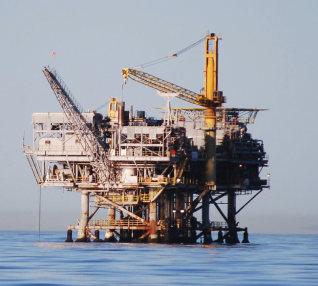
concessions.
The perimeter of the transaction includes Dana Gas’ 100% working interests in the El Manzala, West El Manzala, West El Qantara and North El Salhiya onshore concessions and associated development leases. In the first half of 2020, these concessions produced 30,950 barrels of oil equivalent per day, and contributed US$38mn to the company’s EBITDA. Dana Gas, through its wholly-owned subsidiary Dana Gas Egypt, will retain its interests in its onshore and offshore exploration concessions, respectively El Matariya (Block 3) and North El Arish (Block 6). The transaction is expected to complete early 2021.
Dr Patrick Allman-Ward, CEO, Dana Gas, commented, “Our aim is always to maximise returns to shareholders and optimise our portfolio. The sale of our Egyptian assets forms a key part of this strategy. Completion of the sale process will allow us to strengthen our balance sheet and focus our attention on the development of our world class assets in the KRI, of which our current share of reserves are more than 1bn barrels of oil equivalent.
“The quality of our remaining assets in Egypt is excellent, and we retain an interest in two exploration concessions. Our offshore exploration block in particular is highly prospective.”

bp begins production at Ghazeer gas field
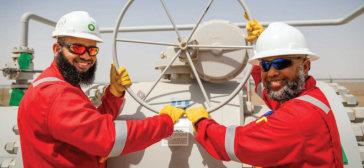
BP, IN PARTNERSHIP with OQ, PETRONAS and the Ministry of Energy & Minerals in Oman, has announced that production has begun from its Block 61 Phase 2 Ghazeer gas field, 33 months after the development was approved.
Ghazeer was initially expected to come into production in 2021. The first phase of development of Block 61 – Khazzan – was The start-up of Ghazeer was achieved safely and brought online in September 2017. ahead of schedule.
His Excellency Dr Mohammed Al Rumhy, Minister of Energy & Minerals of the Sultanate of Oman, stated, “I am delighted to see bp bringing the Ghazeer gas field online – it’s an important project for Oman, and we are extremely proud of it. The gas from Ghazeer will contribute towards Oman’s 2040 vision in terms of providing additional energy to local industries as well as diversifying the economy.”
Bernard Looney, bp chief executive, said, “This project has been delivered with capital discipline four months early, wells are being drilled in record times and, importantly, safety performance has been excellent. It exemplifies what a strong and resilient hydrocarbons business looks like – a core part of our strategy.”
Image credit: bp
Global oil and gas project sanctioning to recover from 2022, says Rystad Energy
RYSTAD ENERGY HAS estimated total sanctioning to bounce back to around US$100bn in 2021, primarily supported by offshore projects, whose value is forecasted at US$64bn for the year.
Although lagging onshore projects are projected to only account for US$36bn in 2021, they will see a steep rise in 2022 to around US$100bn, topping the expected US$95bn worth of offshore commitments that year.
“In this update, we have revised up our 2020 offshore sanctioning total from US$26bn to US$34bn. This was driven by the Mero-3 sanctioning in Brazil, which is estimated to cost US$2.5bn to first oil. MISC has a letter of intent in place with Petrobras for the charter of the FPSO. The contractor will sub-contract the vessel construction work to Chinese yards, with China Merchants Heavy Industry (CMHI) leading the race to build both the hull and topsides. Siemens will deliver the power generation modules, while Aker Solutions is performing frontend engineering and design (FEED) and engineering work on the FPSO topsides,” stated Rystad Energy.
Caterpillar to acquire Weir Oil & Gas

CATERPILLAR HAS SIGNED an agreement to acquire the oil and gas division (Weir Oil & Gas) of the Weir Group PLC, a Scotland-based global engineering business. Weir Oil & Gas produces a full line of pumps, flow iron, consumable parts, wellhead and pressure control products that are serviced via an extensive global network of service centres located near customer operations. “Combining Weir Oil & Gas’s established Image credit: Weir Oil & Gas pressure pumping and pressure control The transaction includes more than 40 Weir Oil & portfolio with Cat’s engines and transmissions Gas manufacturing and services locations. enables us to create additional value for customers,” said Joe Creed, vice-president of Caterpillar’s Oil & Gas and Marine Division. “This acquisition will expand our offerings to one of the broadest product lines in the well service industry.”
The purchase price of US$405mn is to be paid in cash at closing. The acquisition requires approval by Weir shareholders and is subject to review by various regulatory authorities as well as customary closing conditions. The transaction includes more than 40 Weir Oil & Gas manufacturing and services locations and approximately 2,000 employees.
Jon Stanton, Weir Group CEO, said, “We are pleased to have reached this agreement that delivers a great home for the Oil & Gas division. This acquisition will enable Weir Oil & Gas to continue to flourish, ensuring the business remains at the forefront of innovation and customer service in the future.”
Developing net-zero upstream facilities
MCDERMOTT INTERNATIONAL, SCHNEIDER Electric and io consulting have announced a collaboration to advance research and design of carbon-neutral facilities for the upstream oil and natural gas market. The three companies will combine their capabilities and resources to explore and develop a proof of concept based on an offshore platform reference case. The result of the collaboration will be published in a joint study on Net Zero Upstream Facilities before the end of the year.
The study defines a hierarchy of emissions-reduction technologies, ranked by maturity, investment and impact to enable operators to make informed Image credit: Jerry and Pat Donaho/Flickr
The programme directly supports a

significant carbon footprint reduction.
decisions when prioritising areas for emissions reduction.
Samik Mukherjee, McDermott’s group senior vice-president, projects, said, “By combining our strengths, we will deliver solutions that enable our customers to accelerate the industry-shared goal of reducing carbon impact throughout the production chain.”
The programme directly supports a significant carbon footprint reduction within the production and transformation of oil and gas, which, according to the International Energy Agency, is about 15% of the entire oil and gas carbon footprint.
The companies expect the collaboration to demonstrate what is achievable with current technology, what new technologies are required and identify break-even carbon pricing to make the net-zero facilities viable now and in the future.
The team will adapt this proof of concept to any geographical region and project, considering local infrastructure and environmental policies regarding carbon pricing.

Oil production costs reach new lows
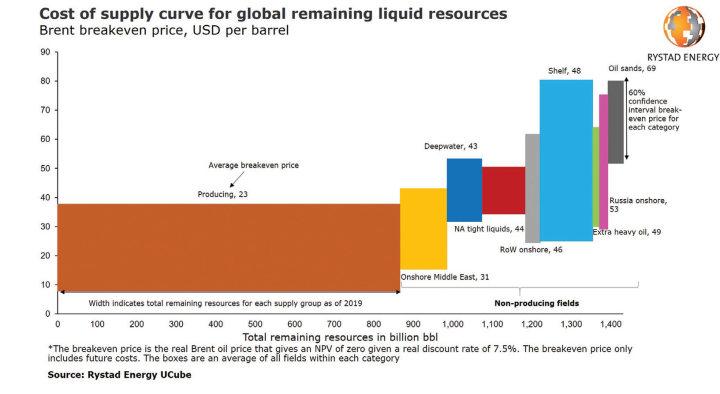
Image source: Rystad Energy
A RYSTAD ENERGY analysis of oil production costs has revealed that the average breakeven price for all unsanctioned projects has dropped to around US$50 per barrel, down around 10% over the last two years, and 35% since 2014. This means that oil is much cheaper to produce now compared to six years ago, with the cost savings winner being new offshore deepwater developments. Rystad projects that an oil price of only US$50 per barrel is needed to keep oil production at 100mn bpd in 2025.
“The implication of falling breakeven prices is that the upstream industry, over the last two years, has become more competitive than ever and is able to supply more volumes at a lower price. However, the average breakeven prices for most of the sources remain higher than the current oil price. This is a clear indication that for upstream investments to rebound, oil prices must recover from their current values,” says Espen Erlingsen, head of Upstream Research at Rystad Energy.
Onshore Middle East is the least expensive source of new production, with an average breakeven price of around US$30 per barrel. This is also the segment with one of the largest resource potential estimates. Offshore deepwater is the second cheapest source of new production, with an average breakeven price of US$43 per barrel, while onshore supply in Russia remains one of the more expensive resources due to the high gross taxes in the country. Shelf remains the segment with the largest resource potential, with 131 billion barrels of unsanctioned volumes.
One of the key drivers of the improved costs and breakeven prices for upstream developments are the lower unit prices within the industry, says Rystad. After the 2015 oil price collapse, oilfield service companies were obliged to reduce the prices they charged E&P companies in order to remain competitive in the challenging market conditions.
AVEVA awarded for achievements in APM market
AVEVA, A GLOBAL leader in engineering and industrial software, has won this year’s Frost Radar Best Practices Award for growth, innovation, and leadership excellence in the asset performance management (APM) market.
AVEVA was recognised with the GIL award for its strong digital and innovative initiatives and features included in its APM 4.0 framework, including AVEVA Insight, a cloud offering that provides end users with actionable insights from anywhere, anytime, and any device.
AVEVA’s APM 4.0 framework (connecting engineering, operations, and performance) enables customers to predict unplanned failures and balances four key value drivers, such as asset performance, safety and compliance, cost control, and resource management, to drive the greatest monetary and business value for customers.
AVEVA’s artificial intelligence (AI) and machine learning (ML) capabilities (e.g., predictive and prescriptive maintenance) are cited as well, which have helped many customers increase equipment reliability and operational performance.
“This award is testament to AVEVA’s strong position in the APM market,” said Kim Custeau, APM business lead at AVEVA. “Frost & Sullivan’s recognition of our APM offering and value delivered to customers this year is a great accomplishment for AVEVA. In a challenging global environment, AVEVA is committed to helping organisations accelerate their digital transformation journey, by helping them manage risk and reduce OPEX.”
CNX RESOURCES AND PDC Energy have installed the VAtitan-TC connection from voestalpine Tubulars, one of the leading providers of full welding solutions.
CNX Resources has installed 27,361 feet of VAtitan-TC on the Maj-12 pad in the Pennsylvania Utica Shale.
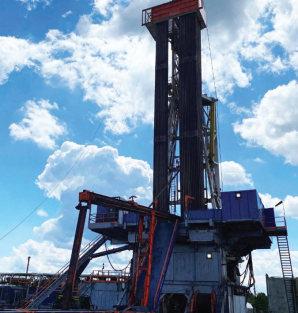
Image credit: voestalpine Tubulars
CNX Resources has installed 27,361 feet of VAtitan-TC on the Maj-12 pad in the Pennsylvania Utica Shale.
voestalpine Tubulars’ newest addition to CNX’s family of premium connections is VAtitan-TC, a wedge type connection with the highest torque rating in the industry. The connection was selected for its ability to withstand extreme torques, often required in such extended reach laterals. With the VAtitan-TC’s deep stabbing, lowturn design, the installation took place in just over 25 hours, with zero breakouts or rejects occurring during the installation.
“The VAtitan-TC connection was very easy to make up at the rig site. The robust thread design and deep stabbing feature made for quick make ups, ensuring a smooth and efficient casing run,” said Luke Beebe, vice-president of drilling, CNX Resources.
PDC Energy has installed 22,248 feet of VAtitan-TC in the Ferguson 23G-202 well located in the Wattenberg Field in the Denver-Julesburg Basin. Extending out 15,640 feet from the KOP, this well has the longest lateral PDC Energy has drilled to date. Due to the long lateral length, a connection able to withstand extreme torque to break static friction was required in the event rotation of casing to bottom was needed.
“Whether the issue is a demand for gas tight connections, or in this application, a need for the highest torque rating in the industry, voestalpine Tubulars has shown to be up to the task,” stated Randall Edwards, president and CEO of Premier Pipe.


